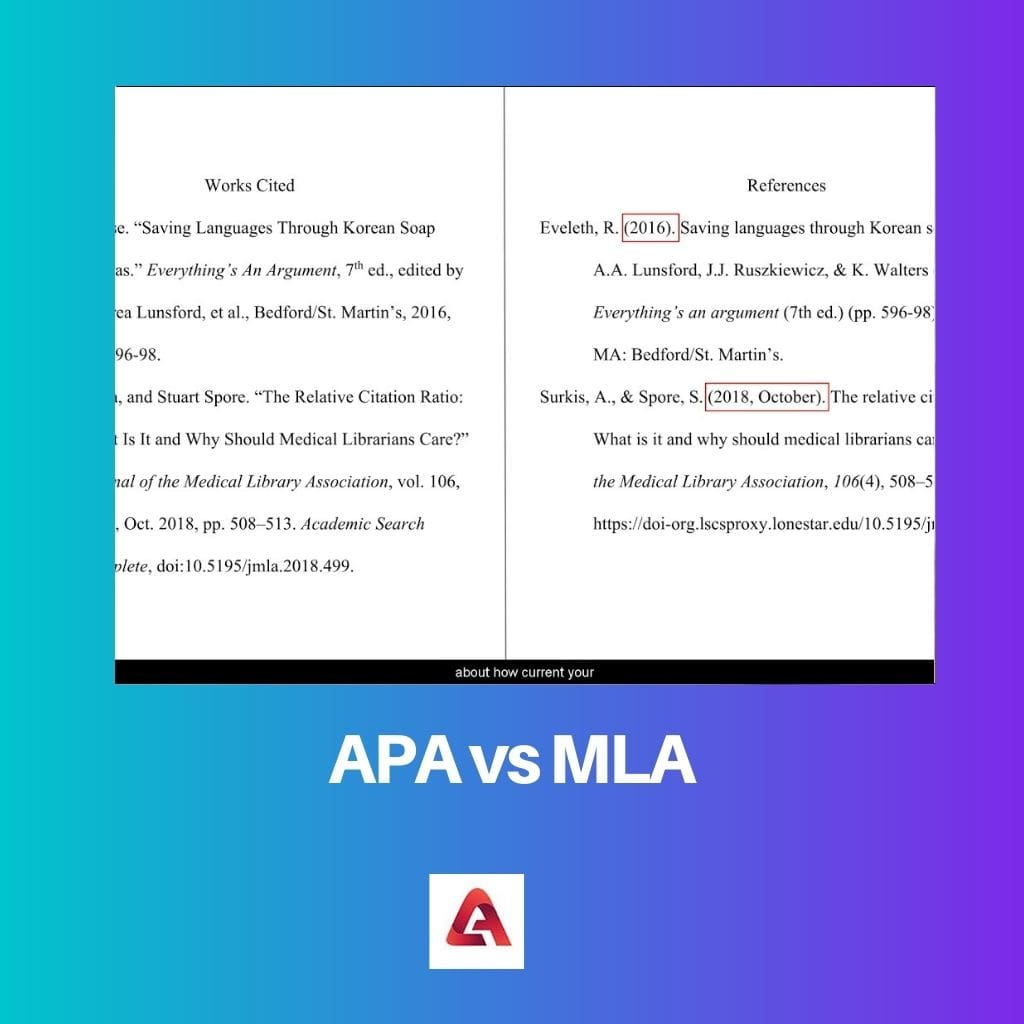APA (American Psychological Association) style is commonly used in social sciences and sciences, featuring in-text citations with author’s last name and year of publication, and a references list at the end. MLA (Modern Language Association) style is often used in humanities, employing in-text citations with author’s last name and page number, and a works cited page at the end. APA focuses on concise and clear writing, while MLA emphasizes literary analysis and the humanities.
Key Takeaways
- APA (American Psychological Association) and MLA (Modern Language Association) are commonly used citation styles.
- APA is used in social sciences, while MLA is used in humanities.
- APA uses in-text citations and a references list, while MLA uses parenthetical citations and works cited page.
APA vs MLA
APA (American Psychological Association) style is most commonly used to cite sources within the social sciences and includes specific guidelines for citing sources in the text and the reference page. MLA (Modern Language Association) style is most used in the humanities, focusing on writing and literature.

The main idea behind the APA style is to provide a comprehensive writing style with proper headlines and works cited lists as references to make it easy for the reader to read and realize.
What makes MLA different from APA are citations and references as work cited with verbs in the present tense.
Comparison Table
| Feature | APA | MLA |
|---|---|---|
| Disciplines | Social sciences, behavioral sciences, natural sciences | Humanities, liberal arts |
| In-text Citation Style | Author-date (e.g., Smith, 2023) | Author-page number (e.g., Smith 23) |
| Reference List | Titled “References” | Titled “Works Cited” |
| Reference List Order | Alphabetical by author’s last name | Alphabetical by first word of entry (excluding articles like “a,” “an,” “the”) |
| Author Last Name in References | Initials only (e.g., A. Smith) | Full name (e.g., Alice Smith) |
| Title Case in References | Sentence case except for major words in journal titles (e.g., The Journal of Psychology) | Title case (e.g., The Joy of Learning) |
| Page Numbers in References | Included for all sources | Included only for print books |
| Database Information in References | Excluded | Included, if available |
| Title Page | Required | Not required, replaced by header with author name, course name, instructor name, and date |
What is APA?
APA style is a set of guidelines established by the American Psychological Association for formatting research papers, manuscripts, and citations in academic and scientific writing. It is widely used in various disciplines within the social sciences, including psychology, sociology, education, and communication.
Key Components of APA Style
- In-text Citations: APA style utilizes parenthetical author-date citations within the text to acknowledge the sources of information used in the paper. This includes the author’s last name and the publication year, e.g., (Smith, 2020). Page numbers are also included when quoting directly from a source.
- References List: At the end of the paper, APA requires a comprehensive list of all sources cited, titled “References.” This list includes detailed bibliographic information for each source cited in the paper, arranged alphabetically by the authors’ last names.
- Formatting Guidelines: APA style specifies guidelines for formatting the title page, abstract, headings, margins, font, and other stylistic elements of a paper. It emphasizes clarity, consistency, and professionalism in written communication.
- Publication Manual: The Publication Manual of the American Psychological Association serves as the official guide to APA style. It provides detailed instructions on how to format papers, cite sources, and construct references accurately.

What is MLA?
MLA style is a set of guidelines established by the Modern Language Association for formatting research papers, manuscripts, and citations in literature, languages, and humanities disciplines. It is commonly used in English studies, literary criticism, cultural studies, and related fields.
Key Components of MLA Style
- In-text Citations: MLA style employs parenthetical author-page citations within the text to acknowledge the sources of information used in the paper. This includes the author’s last name and the page number(s) of the cited information, e.g., (Smith 123). Page numbers are necessary for direct quotations but optional for paraphrased or summarized information.
- Works Cited Page: At the end of the paper, MLA requires a separate page titled “Works Cited,” listing all sources cited in the paper. Entries are organized alphabetically by the authors’ last names or by the title if no author is provided. Each entry includes detailed bibliographic information following a specific format.
- Formatting Guidelines: MLA style specifies guidelines for formatting the title page (if required), headings, margins, font, and other stylistic elements of a paper. It emphasizes simplicity, clarity, and uniformity in written communication.
- MLA Handbook: The MLA Handbook serves as the official guide to MLA style. It provides detailed instructions on how to format papers, cite sources, and construct works cited entries accurately.

Main Differences Between APA and MLA
- In-text Citations:
- APA: Uses author-date format (Author, Year) for in-text citations, often without page numbers.
- MLA: Utilizes author-page format (Author Page) for in-text citations, including page numbers, especially for direct quotations.
- References/Works Cited:
- APA: Requires a references list at the end of the paper, listing all sources cited in alphabetical order.
- MLA: Requires a works cited page at the end of the paper, listing all sources cited in alphabetical order by the author’s last name (or title if no author).
- Formatting Guidelines:
- APA: Emphasizes concise and clear writing, with specific guidelines for title page, headings, margins, font, and overall formatting.
- MLA: Emphasizes simplicity and uniformity, with specific guidelines for headings, margins, font, and overall formatting, often used in literary analysis and humanities studies.
- https://eric.ed.gov/?id=ED314761
- https://okknf.smcebi.edu.pl/orwi07756sdo/11-prof-karina-gutkowski/rxJXL4Lpg4f-the-essentials-of-mla-style-a-guide-to-documenta-doc.pdf

The post effectively outlines the fundamental differences between APA and MLA, catering to readers from various academic backgrounds and disciplinary interests.
I concur with Hellis. The comparison aids in understanding the contexts in which each citation style is applicable.
Absolutely. The article’s clarity in presenting the distinctions between APA and MLA is commendable.
A well-written article that effectively explains the roles and responsibilities of Members of Legislative Assembly in parliamentary democracies. It provides valuable insights into their contributions to the legislative process.
The content effectively captures the significance of MLA and the essential roles of Members of Legislative Assembly in representing the interests of their constituents. It’s an insightful read.
I couldn’t agree more. The article provides a detailed understanding of MLA and the diverse responsibilities of MLAs, contributing to a better understanding of the legislative process.
The distinctions between APA and MLA are effectively elucidated in the post, facilitating a nuanced understanding of the divergent citation styles.
Absolutely. The article offers a thorough comparison to aid readers in discerning the appropriate usage of APA and MLA.
The article provides a foundational understanding of APA and MLA, yet it could incorporate engaging examples to highlight practical applications in academic writing.
Certainly. The inclusion of case studies could make the content more relatable and impactful for readers.
I share your sentiment. Real-world examples would enhance the article’s educational value.
This article provides a comprehensive and clear comparison between APA and MLA citation styles. It’s very informative and helps readers understand the key differences.
I agree! The article presents a detailed analysis of the two styles and their specific usage.
The article offers a comprehensive overview of MLA and the pivotal role of Members of Legislative Assembly in parliamentary democracies. It’s quite enlightening.
This content is highly enlightening. It clarifies the primary usage, citation style, and reference list format of both APA and MLA, making it easier to differentiate between the two.
The article offers a thorough understanding of APA and MLA, emphasizing their usage and unique citation style differences. It’s a valuable resource for academic writing.
The distinction between APA and MLA could be further explored with more emphasis on the impact of these citation styles in academic writing and research.
I share the same view. A deeper analysis of the practical implications of APA and MLA in academic work would enhance the article’s content.
Agreed. Exploring the relationship between citation styles and quality of research would add more depth to the discussion.
Although the post provides valuable insights into APA and MLA, it could benefit from some real-life examples to illustrate the differences in citation styles.
The article succinctly summarizes the primary differences between APA and MLA, offering a comprehensive overview to readers seeking clarity on citation styles.
The article effectively highlights the significance of the American Psychological Association and its role in providing comprehensive style guidelines. The influence of APA in research and academic settings is clearly articulated.
I appreciate the in-depth coverage of APA membership and advocacy efforts. It showcases the association’s commitment to advancing psychology as a science and promoting mental health awareness.
Absolutely! The emphasis on ethical considerations in research and diverse perspectives in scholarly work reflects the commitment of APA to maintain academic integrity.
I find the comparison table provided in the article very helpful. It offers a concise overview of the key differences in citation style between APA and MLA.
The distinction between APA and MLA citation styles is articulated with remarkable clarity in this content. It’s a valuable reference for academic writing and research.
The article successfully highlights the key differences between APA and MLA, providing an insightful comparison of their citation styles and usage in different academic disciplines.
I agree. The comprehensive comparison makes it easy to understand the nuances of APA and MLA styles.
Indeed, the detailed comparison will be helpful for students and researchers in understanding when to use each citation style.
While the article explicates the distinctions between APA and MLA, it overlooks the evolving trends in citation styles and the implications for contemporary scholarly work.
Indeed, an exploration of the evolving nature of citation styles in the digital age would enrich the discussion.
The article’s comprehensive overview of APA and MLA serves as a valuable resource for students and researchers navigating the complexities of citation styles in academia.
The detailed explanation of APA style and its emphasis on clarity and precision is particularly noteworthy. It sheds light on the importance of systematic citation of sources in academic writing.
The post lacks a critical evaluation of the evolution and relevance of APA and MLA in contemporary academic writing and research practices.